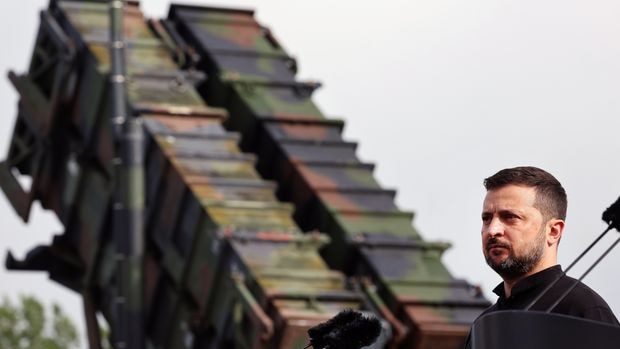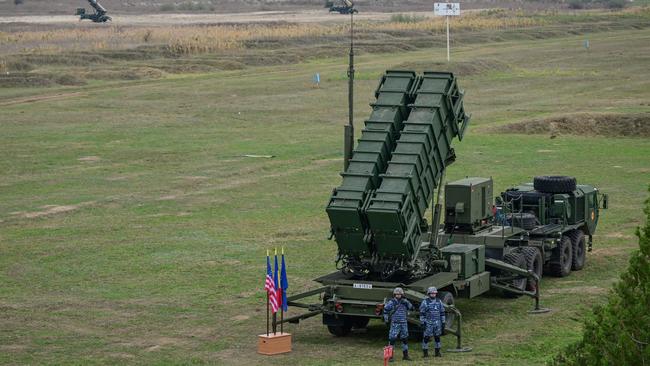US to redirect air-defence missile deliveries to Ukraine
Other American allies and partners with contracts for interceptor missiles will face delays.

The Biden administration will rush the delivery of air-defence interceptors to Ukraine by halting delivery to allied nations, the White House said.
President Joe Biden hinted at the move last week during the Group of Seven meeting in Italy, saying: “We let it be known to those countries that are expecting from us air-defence systems in the future that they’re going to have to wait.”
John Kirby, a spokesman for the National Security Council, said on Thursday that Ukraine would get the additional interceptors by the end of summer. “The broader message here to Russia is clear, if you think you’re going to be able to outlast Ukraine, and if you think you’re going to be able to outlast those of us who are supporting Ukraine, you’re just flat-out wrong,” Mr Kirby said.
The decision to redirect US production of air-defence interceptors reflects the limits of the Western defence-industrial base, which has struggled to supply enough armaments to meet global demand. It also is an acknowledgment of Ukraine’s urgent need amid intensified attacks by Russia.
While the administration wouldn’t say how many interceptors it would send, a senior US official said Ukraine would be given priority over the next 16 months, and the missiles would be delivered to Kyiv as they come off the assembly line.
Ukraine will receive interceptors for both Patriots and the National Advanced Surface-to-Air Missile System, or Nasams.
Among the nations that had contracts to buy interceptors and likely will be affected are South Korea and the United Arab Emirates, a congressional official said.
Mr Kirby declined to say how many countries were affected by reprioritising the air-defence deliveries. He said it wouldn’t affect Israel or Taiwan.
Ukrainian President Volodymyr Zelensky has said his country urgently needs at least seven more Patriot batteries, which are used to launch the interceptors. The US said last week that it would send Ukraine an additional Patriot battery to protect against Russian attacks and that it was seeking other systems from allies.

There are at least three Patriots batteries in Ukraine. On Thursday, Romania said it would also send a Patriot system. “This crucial contribution will bolster our air shield and help us better protect our people and critical infrastructure from Russian air terror,” Mr Zelensky said in response to Romania’s announcement.
Patriot batteries, which have helped protect Ukrainian troops and civilian assets over recent months, including around Kyiv, include radar, launchers and interceptor systems. Each can fire dozens of interceptors in a single engagement to attack planes, missiles or rockets. Nasams, a short-to-medium range air-defence system, can launch 72 interceptors at once.
Over the last several months, air defence has been one of the top requests from Ukraine as it has sought to both defend its front lines and protect its cities and civilian infrastructure. Russia’s targeted strikes against Ukraine’s power infrastructure have cut electricity production by half, leading to blackouts.
Mr Zelensky intensified calls for more air-defence systems this spring after Russia’s military ramped up bombing of Kharkiv, Ukraine’s second-largest city, which sits near Russian territory.
Ukrainian Defence Minister Rustem Umerov said earlier this month that his country needed twice the number of Patriot systems and interceptors.
Russia has long used ballistic and cruise missiles, as well as lethal drones, against Ukrainian cities. In recent months, Moscow’s forces have increased their use of massive glide bombs, launched from aircraft behind the front lines.
The administration began considering changing its delivery of interceptors in April, as Russia launched its assault on Kharkiv. At the time, the flow of US military aid had slowed to a trickle while congress struggled to pass a package that included nearly $US61bn ($91.5bn) for Ukraine.
Shortly after that bill passed later that month, the Pentagon said it was rushing aid to Ukraine, including interceptors for the Patriot and began steps to halt delivery to allied partners, the administration official said.
Mr Biden informed his Ukrainian counterpart about the latest US plan in Italy, the administration official said.
In the past, the administration has said no one system would give Ukraine the upper hand.
“On the battlefield, in terms of the outcome of the war, it’s not a game changer by itself,” said Seth G. Jones, senior vice-president at the Washington-based Centre for Strategic and International Studies. “Air defence is not sufficient for Ukraine to reclaim territory or break the Russian line.”
The Wall Street Journal



To join the conversation, please log in. Don't have an account? Register
Join the conversation, you are commenting as Logout